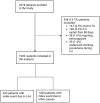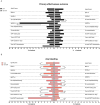Real-World Dual Antiplatelet Therapy Use Exceeds Randomized Trials Boundaries With Possible Safety Issues in Patients With Large Artery Atherosclerosis-Insights From the READAPT Study
- PMID: 40265654
- PMCID: PMC12015746
- DOI: 10.1111/ene.70163
Real-World Dual Antiplatelet Therapy Use Exceeds Randomized Trials Boundaries With Possible Safety Issues in Patients With Large Artery Atherosclerosis-Insights From the READAPT Study
Abstract
Background and aim: According to randomized controlled trials (RCTs), dual antiplatelet therapy (DAPT) is more effective for secondary prevention of ischemic events attributable to large artery atherosclerosis (LAA) than other mechanisms. We investigated whether real-world application may impact DAPT effectiveness and safety in the REAl-life study on short-term Dual Antiplatelet treatment in Patients with ischemic stroke or Transient ischemic attack (READAPT, NCT05476081).
Methods: READAPT was an observational multicenter study including patients with minor ischemic stroke or TIA treated with short-term DAPT. At 90 days, we assessed primary effectiveness (ischemic recurrence, severe bleeding, or vascular death) and safety (severe to moderate bleeding) outcomes. We explored associations between LAA and outcomes using Cox regression. Within patients with and without LAA, outcomes were compared between subgroups based on age, NIHSS score (for ischemic stroke patients), ABCD2 score (for TIA patients), presence and number of MRI acute lesions, and DAPT regimen characteristics.
Results: Among 1920 analyzed patients (of 2278 enrolled), 452 had LAA. Unlike RCTs, 21.2% of patients with LAA had NIHSS > 5, and 48.2% received DAPT > 30 days. Patients with LAA had higher bleeding rates (3.5% vs. 2.1%, p = 0.004), primarily hemorrhagic infarctions and moderate bleeding, than those without LAA. However, primary effectiveness outcomes were similar (4.9% vs. 3.5%, p = 0.201) between the groups. In patients with LAA, prolonged DAPT (> 21 days), multiple MRI lesions, age ≥ 65, and loading doses increased bleeding risk.
Conclusions: The real-world DAPT use in patients with LAA exceeds RCTs boundaries with possible drawbacks on treatment safety.
Keywords: TIA; dual antiplatelet therapy; large artery atherosclerosis; minor ischemic stroke; real world.
© 2025 The Author(s). European Journal of Neurology published by John Wiley & Sons Ltd on behalf of European Academy of Neurology.
Conflict of interest statement
A.Z. reports compensation from Angels Initiative, Boehringer‐Ingelheim, Daiichi Sankyo, CSL Behring, Bayer, and Astra Zeneca; and he is a member of ESO guidelines, ISA‐AII guidelines, and IRETAS steering committee. R.O. reports compensations from Novartis and Allergan, Teva Pharmaceutical Industries, Eli Lilly and Company. S.S. reports compensations from Novartis, NovoNordisk, Allergan, AstraZeneca, Pfizer Canada Inc., Eli Lilly and Company, Teva Pharmaceutical Industries, H. Lundbeck A/S, and Abbott Canada; employment by Università degli Studi dell'Aquila. M.Pa. reports compensation from Daiichi Sankyo Company, Bristol Myers Squibb, Bayer, and Pfizer Canada Inc. D.T. reports compensation from Alexion, AstraZeneca, Medtronic, and Pfizer. The other authors report no conflicts.
Figures





References
-
- Kolominsky‐Rabas P. L., Weber M., Gefeller O., Neundoerfer B., and Heuschmann P. U., “Epidemiology of Ischemic Stroke Subtypes According to TOAST Criteria: Incidence, Recurrence, and Long‐Term Survival in Ischemic Stroke Subtypes: A Population‐Based Study,” Stroke 32, no. 12 (2001): 2735–2740, 10.1161/hs1201.100209. - DOI - PubMed
-
- Bulwa Z., Saleh Velez F. G., Brorson J. R., and Pinto C. B., “Ipsilateral Nonstenotic Carotid Disease in Minor Ischemic Stroke: An Exploratory Analysis of the POINT Randomized Clinical Trial,” Journal of Stroke and Cerebrovascular Diseases 29, no. 11 (2020): 105115, 10.1016/j.jstrokecerebrovasdis.2020.105115. - DOI - PubMed
Publication types
MeSH terms
Substances
Associated data
LinkOut - more resources
Full Text Sources
Medical

